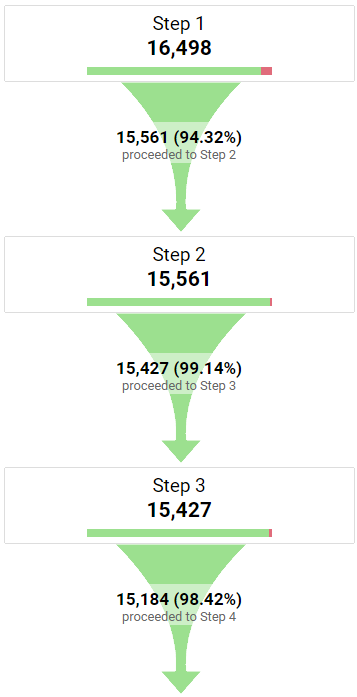Understanding What Data Is Google Analytics Goals Unable to Track
Understanding What Data Is Google Analytics Goals Unable to Track
Blog Article
Discover the Limitations of Google Analytics Goals: Revealing the Information Types That Remain Untrackable
As organizations progressively count on data-driven decision-making, understanding the restrictions of devices like Google Analytics becomes critical. While Google Analytics Goals deal beneficial insights right into customer interactions, there exist information types that elude monitoring, positioning challenges to a detailed understanding of individual habits.
Incomplete Individual Journey Tracking
Incomplete user journey monitoring within Google Analytics can impede the capacity to accurately examine customer actions. When the customer trip is not totally tracked, there are gaps in the data that avoid a comprehensive understanding of how customers connect with a web site. This absence of understanding can lead to missed out on chances for optimization and improvements to the individual experience.
One typical problem with incomplete individual trip monitoring is the lack of ability to see the complete course that customers take before completing a goal or leaving the website. Without this details, it is testing to determine where individuals may be coming across barriers or rubbing points that prevent them from converting. Additionally, insufficient tracking can cover the impact of certain advertising and marketing initiatives or site changes on individual actions.
To resolve this restriction, it is essential to establish up appropriate tracking devices within Google Analytics to catch the entire user trip. This may involve establishing occasion tracking, objective funnels, or using tools like Google Tag Supervisor to make sure that no essential interactions go unrecorded. By acquiring an extensive sight of the individual journey, internet site owners can make even more educated decisions to enhance customer interaction and drive conversions.
Attribution Difficulties
Browsing via acknowledgment challenges in Google Analytics calls for a detailed understanding of how different touchpoints contribute to the general conversion procedure. Acknowledgment obstacles emerge from the complexity of modern-day consumer trips, where customers interact with multiple channels before converting.
One typical attribution obstacle is the problem in attributing conversions to the correct resource, particularly in instances where customers communicate with several networks before transforming. Additionally, cross-device monitoring postures another attribution obstacle, as individuals typically change in between gadgets throughout their journey, making it challenging to track their interactions perfectly.
Offline Conversions
Given the obstacles related to attributing conversions precisely in online channels, the measurement of offline conversions offers a considerable opportunity for online marketers looking for a more detailed understanding of their consumers' journey. Offline conversions describe activities that consumers take in the physical globe, such as making acquisitions in brick-and-mortar stores or over the phone, attending occasions, or involving with printed materials - what data is google analytics goals unable to track. These conversions are crucial for companies that operate both online and offline, as they supply useful understandings into the performance of marketing campaigns across numerous touchpoints
Tracking offline that site conversions typically postured a considerable obstacle for marketers, as it was testing to link these actions back to certain on the internet interactions properly. With improvements in innovation, such as the assimilation of CRM systems, unique identifiers, and discount coupon codes, companies can currently link the void in between online and offline data to acquire a much more alternative view of client behavior. By efficiently determining offline conversions, marketing experts can optimize their strategies, assign sources more successfully, and ultimately enhance the overall consumer experience.
Cross-Device Tracking
Cross-device monitoring plays a critical duty in comprehending the interconnected nature of consumers' electronic communications throughout numerous gadgets. In today's omnichannel world, where individuals effortlessly change in between desktops, check my site smartphones, and tablet computers, tracking their behavior across these tools is important for marketing experts to acquire a comprehensive view of their consumer journey.

Furthermore, privacy problems and policies such as GDPR and CCPA have better complex cross-device tracking. With customers demanding more control over their data and increased limitations on monitoring modern technologies, marketing professionals should locate privacy-compliant and ingenious ways to attach individual interactions throughout gadgets.
Dynamic Material Engagement
Comprehending customer engagement with vibrant material is crucial in enhancing digital advertising methods for improved audience communication. Dynamic web content describes internet site elements that change based upon user actions, choices, or various other variables, providing a personalized experience. Tracking user communications with vibrant content poses obstacles for standard analytics tools like Google Analytics.
While Google Analytics can track standard interactions like clicks and web page views, it might have a hard time to record even more nuanced involvements within vibrant material. what data is google analytics goals unable to track. Metrics such as time spent on details vibrant elements, float activities, or interactions within pop-ups are frequently not easily quantifiable using conventional monitoring techniques. This limitation impedes marketers' ability to fully understand how individuals are involving with dynamic content and tailor their strategies appropriately

Conclusion
Finally, Google Analytics objectives have limitations in tracking insufficient user trips, attributing conversions properly, catching offline conversions, tracking cross-device communications, and determining vibrant material interaction. These constraints highlight the importance of checking out additional monitoring techniques and devices to acquire an extra comprehensive understanding of user habits and conversions past what Google Analytics can provide.
While Google Analytics Goals offer important insights right into customer communications, there exist data types that elude monitoring, posturing obstacles to an extensive understanding of individual behavior.Incomplete user trip monitoring within Google Analytics can impede the capacity to precisely examine individual habits. When the individual journey is not completely tracked, there are spaces in the data that stop a thorough understanding of just how users connect with a website.One typical issue with incomplete user trip monitoring is the failure to see the full course that individuals take previously completing an objective or leaving the website. By getting a detailed view of the user journey, internet site proprietors can make more informed choices to boost user involvement and drive conversions.
Report this page